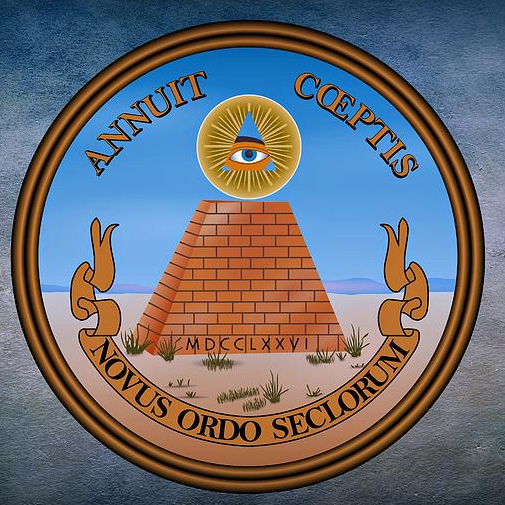Copy of The Great Seal of the United States: History, Symbolism, and Legacy
- Feature

- Aug 9
- 4 min read
By Dr. John Hill, Editor & CEO
**This blog post is derived from a much longer presentation I made for a civic organization recently. Perhaps you may find it historically significant and educational. Information taken from:
"The Great Seal of the United States," Booklet, by the US State Department (2003)
"The History of The Seal of the United States," by The US State Department (1909)

Most Americans see the Great Seal of the United States every day on the back of a one-dollar bill, yet few know the powerful story behind this national emblem. More than just a decorative symbol, the Great Seal reflects the core values, aspirations, and identity of the American republic. From its origins in the Revolutionary era to its continued use today, the Seal captures the nation's enduring spirit.

The Birth of a National Symbol
The story of the Great Seal began on July 4, 1776. As the ink dried on the Declaration of Independence, Congress appointed Benjamin Franklin, John Adams, and Thomas Jefferson to design a national seal. Their proposals drew heavily on biblical and classical imagery—Moses parting the Red Sea, the Israelites in the wilderness, and Hercules choosing between virtue and sloth. Artist Pierre Eugene du Simitiere added heraldic elements such as the Eye of Providence and the Latin motto E Pluribus Unum, meaning "Out of many, one."
Despite their efforts, Congress rejected the design. A second committee formed in 1780, incorporating new features like the red and white stripes, a constellation of 13 stars, and the olive branch of peace. Still, the design was not approved.

It wasn't until 1782 that the final version began to take shape. William Barton, working with a third committee, introduced the idea of an unfinished pyramid and the Eye of Providence. Charles Thomson, Secretary of Congress, unified the best elements from all previous designs. He replaced the white eagle with the American bald eagle, added arrows, and preserved the symbolic reverse with the pyramid and divine eye. Congress officially adopted Thomson’s design on June 20, 1782.
Decoding the Great Seal
The Great Seal has two sides: the obverse (front) and the reverse (back).
On the Front:
Bald Eagle: A symbol of strength and freedom. (The Eagle facing towards Peace, since 1945, ordered by President Truman)
Shield: Featuring 13 red and white stripes for the original states and a blue chief representing Congress.
Arrows and Olive Branch with Fruit: Representing the power of war and peace (and prosperity).
Motto – E Pluribus Unum: "Out of many, one," symbolizing unity.
Constellation of 13 Stars: A new nation among sovereign powers.

On the Back:
Unfinished Pyramid: Symbolizes strength and the nation’s ongoing growth.
Eye of Providence: Represents divine guidance.
Annuit Coeptis: “He (God) has favored our undertakings.”
Novus Ordo Seclorum: “A new order of the ages,” marking the American era beginning in 1776.
Artistic Evolution Over Time
Since its adoption, the Seal has undergone various artistic refinements:
In 1825, Seraphim Masi designed a special version for treaties.
The 1841 and 1877 versions contained errors such as incorrect star and arrow counts.
In 1885, Tiffany & Co. restored its heraldic integrity.
The current version, engraved by Max Zeitler in 1904, corrected past mistakes and is still used today.
Everyday Uses of the Seal
The Great Seal is more than ceremonial. It’s used thousands of times each year to:
Ratify treaties
Authenticate presidential proclamations
Appoint ambassadors and high-ranking officials
You’ll also find the Coat of Arms from the Seal’s front on U.S. passports, embassy signage, official publications, coins, stamps, and even in the Capitol’s stained glass.
The reverse, though never made into a physical die, became publicly familiar after 1935 when President Franklin D. Roosevelt approved its placement on the back of the dollar bill.

Legal Protections and Access
Use of the Seal is legally restricted and managed by the U.S. Department of State. It cannot be used commercially or reproduced for non-official purposes. The actual die is securely housed in the Department of State’s Exhibit Hall and used only under the Secretary of State’s authority.
A Living Legacy
Despite being over two centuries old, the Great Seal remains a vibrant emblem of American ideals. Its eagle, stars, mottoes, and pyramid all represent the vision of the Founders—unity, perseverance, divine favor, and a new beginning.
Every time you see the Seal, whether on a dollar bill or a government building, you’re witnessing a piece of the nation’s foundational story. It reminds us not only of where we came from but of the principles that continue to shape our journey forward.
Let us honor this symbol—not for mystery or myth—but for its enduring message of unity, strength, and liberty.




Comments